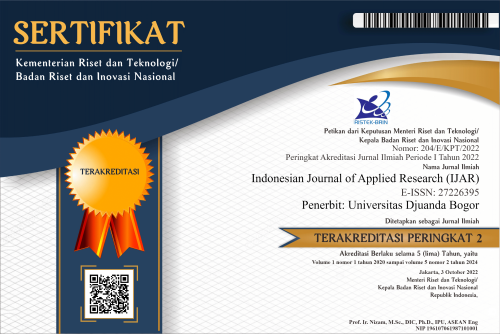Oxalic Acid Production of Banana Peel (Musa Textilia) Through Optimum Temperature and Time with Alkaline Method
Abstract
The chemical compound has the formula H2C2O4 is oxalic acid. Every year especially, the industrial sector in Indonesia requires oxalic acid made, which increases annually. Oxalic acid is valuable because it may be used to clean (rust remover), make colors, protect metals from corrosives, and other things. Alkaline melting is one way for creating oxalic acid from cellulose-containing materials. Other methods include hydrolysis, CaCl2 precipitation, and acidification using H2SO4. In Indonesia, cellulose-containing materials are widely available. Banana peels are one of the substances that contain cellulose. In addition to identifying the properties of oxalic acid produced using the alkaline smelting process, this study attempts to find the best temperature and duration for producing oxalic acid from discarded banana peels. The ideal conditions include a temperature of 60°C, a period of 60 minutes, and a yield of 5.42%. Oxalic acid from banana peel waste has the properties of having a melting point, hydroxyl, C=C, C-O, and C-H group absorption at a wave number of 104.6 oC, 3422.06 cm-1, 1682.48 cm-1, 1103.42 cm-1, and 666.36 cm-1 respectively. Based on the strain vibration results from the FTIR test and melting point test.
References
Anhwange, B.A., Ugye, T.J. and Nyiaatagher, T.D. (2009). Chemical composition of Musa sapientum (banana) peels. Electronical Journal of Environmental, Agricultural and Food Chemistry, Volume 8(6) , 437-442.
Cinantya, P. (2015). Ekstraksi Asam Oksalat dari Tongkol Jagung dengan Pelarut HNO3. Semarang: Fakultas Teknik Universitas Negeri Semarang.
Kiantoro. (2011). Pembuatan Asam Oksalat dari Limbah Pisang Pengaruh Waktu dan Konsentrasi Asam Oksalat (HNO3). Palembang: Politeknik Negeri Sriwijaya.
Kirk, R. a. (2007). Encyclopedia of Chemical Technology. New York: John Wiley and Sons. Inc.
Luthfiralda Sjahfirdi, Nikki Aldi, Hera Maheshwari and Pudji Astuti. (2015). Aplikasi Fourier Transform Infrared (FTIR) dan Pengamatan Pembengkakan Genital pada Spesies Primata, Lutung Jawa (Trachypithecus Auratus) untuk Mendeteksi Masa Subur. Jurnal Kedokteran Hewan Vol.9 (2) , 1978-225X.
Munadjim. (1983). Teknologi Pengolahan Pisang. Jakarta: PT Gramedia Pustaka Utama.
Narimo. (2010). Pembuatan Asam Oksalat dari Peleburan Kertas Koran Bekas dengan Larutan NaOH. Jurnal Kimia dan Teknologi Volume 2(5) , 1-7.
Sawada H and T Murakami. (2000). Oxalic acid. Kirk-Othmer Encyclopedia of Chemical Technology. New York: John Wiley & Sons, Inc.
SJC. (2015). Safety Data Sheet : Oxalic Acid Dihydrate. Compliance Education.Inc.
Copyright (c) 2023 Indonesian Journal of Applied Research (IJAR)

This work is licensed under a Creative Commons Attribution-ShareAlike 4.0 International License.
The Authors submitting a manuscript do so on the understanding that if accepted for publication, copyright publishing of the article shall be assigned/transferred to Indonesian Journal of Applied Research (IJAR) Universitas Djuanda as Publisher of the journal. Upon acceptance of an article, authors will be asked to complete a 'Copyright Transfer Agreement'. An e-mail will be sent to the corresponding author confirming receipt of the manuscript together with a 'Copyright Transfer Agreement' form by online version of this agreement.
Indonesian Journal of Applied Research (IJAR) Universitas Djuanda, the Editors and the Editorial Board make every effort to ensure that no wrong or misleading data, opinions or statements be published in the journal. In any way, the contents of the articles and advertisements published in the Indonesian Journal of Applied Research (IJAR) Universitas Djuanda are sole and exclusive responsibility of their respective authors and advertisers.
Remember, even though we ask for a transfer of copyright, our journal authors retain (or are granted back) significant scholarly rights as mention before.
The Copyright Transfer Agreement (CTA) Form can be downloaded here: Copyright Transfer Agreement-IJAR 2020
The copyright form should be signed electronically and send to the Editorial Office e-mail below:
Prof. Dr. Ir. Dede Kardaya, M.Si. (Editor-in-Chief)
Universitas Djuanda
Jl. Tol Jagorawi No.1, Ciawi, Kec. Ciawi, Bogor, Jawa Barat 16720
Website: http://journal.unida.ac.id/index.php/IJAR/index
Email: ijar@unida.ac.id






 This work is licensed under a
This work is licensed under a 